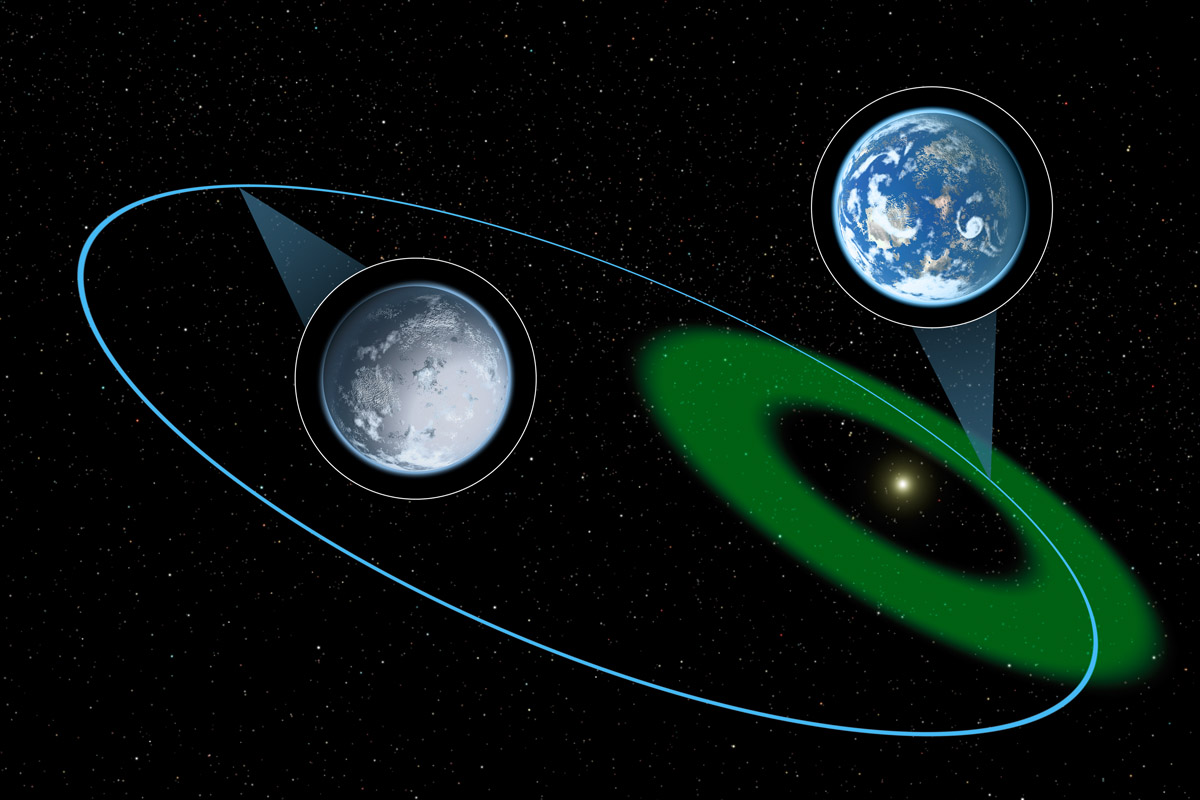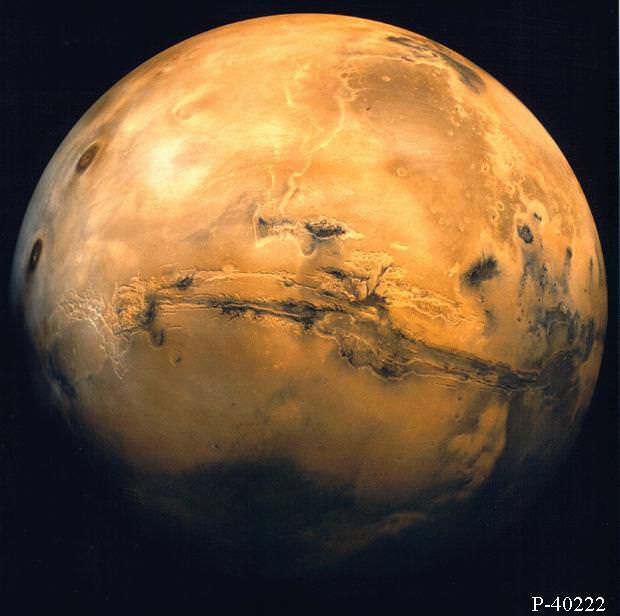When we think about finding life beyond Earth, especially on exoplanets, we immediately want to search for the next Earth, or Earth 2.0. We want an exoplanet that orbits a star firmly in its habitable zone (HZ) with vast oceans of liquid water, and plenty of land to go around. An exoplanet like that most certainly has life, right? But what if we’re looking in the wrong places? What if we find life on exoplanets that don’t possess the aforementioned characteristics, i.e., Earth 2.0?
Continue reading “Searching for Life on Highly Eccentric Exoplanets”What is the Average Surface Temperature of Mercury?

Of all the planets in the Solar System, Mercury is the closest to our Sun. As such, you would think it is the hottest of all the Solar planets. But strangely enough, it is not. That honor goes to Venus, which experiences an average surface temperature of 750 K (477 °C; 890 °F). Not only that, but Mercury is also cold enough in some regions to maintain water in ice form.
Overall, Mercury experiences considerable variations in temperatures, ranging from the extremely hot to the extremely cold. All of this arises from the fact that Mercury has an extremely thin atmosphere, as well as the nature of its orbit. Whereas the side facing the Sun experiences temperatures hot enough to melt lead, the darkened areas are cold enough to freeze water.
Orbital Characteristics:
Mercury has the most eccentric orbit of any planet in the Solar System (0.205). Because of this, its distance from the Sun varies between 46 million km (29 million mi) at its closest (perihelion) to 70 million km (43 million mi) at its farthest (aphelion). And with an average orbital velocity of 47.362 km/s (29.429 mi/s), it takes Mercury a total 87.969 Earth days to complete a single orbit around the Sun.
With an average rotational speed of 10.892 km/h (6.768 mph), Mercury also takes 58.646 days to complete a single rotation. This means that Mercury has a spin-orbit resonance of 3:2, which means that it completes three rotations on its axis for every two orbits around the Sun. This does not, however, mean that three days last the same as two years on Mercury.
In fact, its high eccentricity and slow rotation mean that it takes 176 Earth days for the Sun to return to the same place in the sky (aka. a solar day), which means that one day is twice as long as a single year on Mercury. The planet also has the lowest axial tilt of any planet in the Solar System – approximately 0.027° compared to Jupiter’s 3.1°, (the second smallest). This means that there is virtually no seasonal variation in surface temperature.
Exosphere:
Another factor that affects Mercury’s surface temperatures is its extremely thin atmosphere. Mercury is essentially too hot and too small to retain anything more than a variable “exosphere”, one which is made up of hydrogen, helium, oxygen, sodium, calcium, potassium and water vapor.
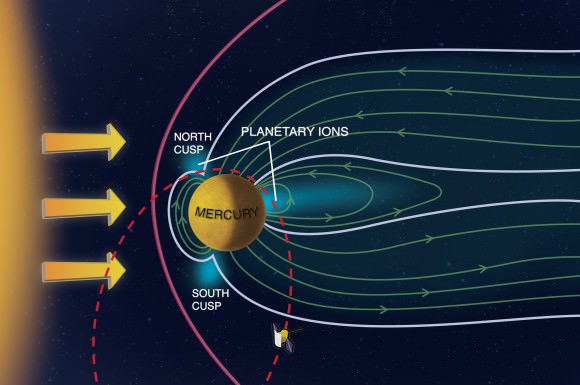
These trace gases have a combined atmospheric pressure of about 10-14 bar (one-quadrillionth of Earth’s atmospheric pressure). It is believed this exosphere was formed from particles captured from the Sun, volcanic outgassing and debris kicked into orbit by micrometeorite impacts.
Surface Temperatures:
Because it lacks a viable atmosphere, Mercury has no way to retain the heat from the Sun. As a result of this and its high eccentricity, the planet experiences considerable variations in temperature between its light side and dark side. Whereas the side that faces the Sun can reach temperatures of up to 700 K (427° C; 800 °F), the side in shadow dips down to 100 K (-173° C: -279 °F).
Despite its extreme highs in temperature, the existence of water ice and even organic molecules has been confirmed on Mercury’s surface, specifically in the cratered northern polar region. Since the floors of these deep craters are never exposed to direct sunlight, temperatures there remain below the planetary average.
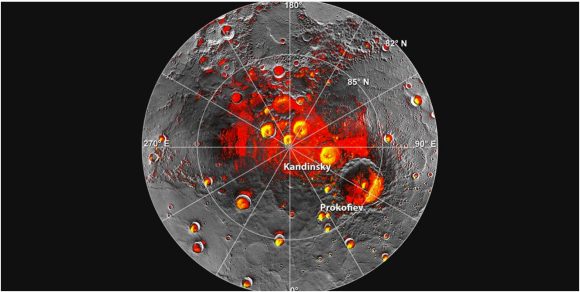
These icy regions are believed to contain about 1014–1015 kg of frozen water, and may be covered by a layer of regolith that inhibits sublimation. The origin of the ice on Mercury is not yet known, but the two most likely sources are from outgassing of water from the planet’s interior or deposition by the impacts of comets. There are thought to be craters at the south pole as well, where temperatures are similarly cold enough to sustain water in ice form.
Mercury is a planet of extremes. It has an extremely eccentric orbit, an extremely thin-atmosphere, and experiences extremely hot and cold surface temperatures. Little wonder then why there is no life on the planet (at least, that we know about!) But perhaps someday, human beings may live there, sheltered in the cratered regions and using the water ice to create a habitat.
We have written many interesting articles about the average surface temperatures of the planets. Here’s What is the Average Surface Temperature of the Planets in our Solar System?, What is the Average Surface Temperature of Venus?, What is the Average Surface Temperature of Earth?, What is the Average Surface Temperature of Mars?, What is the Average Surface Temperature of Jupiter?, What is the Average Surface Temperature of Saturn?, What is the Average Surface Temperature of Uranus?, What is the Average Surface Temperature of Neptune?, and What is the Average Surface Temperature of Pluto?
If you’d like more information on Mercury, check out NASA’s Solar System Exploration Guide, and here’s a link to NASA’s MESSENGER Misson Page.
We have also recorded a whole episode of Astronomy Cast that’s just about planet Mercury. Listen to it here, Episode 49: Mercury.
Sources:
A Pulsar and White Dwarf Dance Together In A Surprising Orbit

Searching the Universe for strange new star systems can lead to some pretty interesting finds. And sometimes, it can turn up phenomena that contradict everything we think we know about the formation and evolution of stars. Such finds are not only fascinating and exciting, they allow us the chance to expand and refine our models of how the Universe came to be.
For instance, a recent study conducted by an international team of scientists has shown how the recent discovery of binary system – a millisecond pulsar and a low-mass white dwarf (LMWD) – has defied conventional ideas of stellar evolution. Whereas such systems were believed to have circular orbits in the past, the white dwarf in this particular binary orbits the pulsar with extreme eccentricity!
To break it down, conventional wisdom states that LMWDs are the product of binary evolution. The reason for this is because that under normal circumstances, such a star – with low mass but incredible density – would only form after it has exhausted all its nuclear fuel and lost its outer layers as a planetary nebula. Given the mass of this star, this would take about 100 billion years to happen on its own – i.e. longer than the age of the Universe.
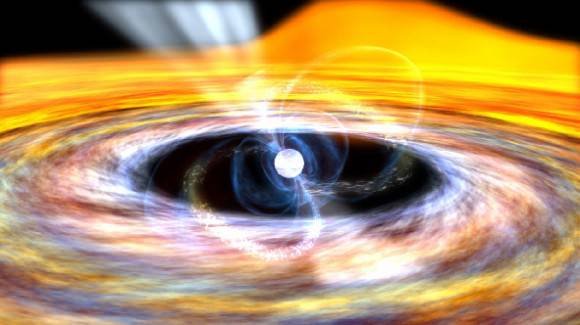
As such, they are generally believed to be the result of pairing with other stars – specifically, millisecond radio pulsars (MSPs). These are a distinct population of neutron stars that have fast spin periods and magnetic fields that are several orders of magnitude weaker than that of “normal” pulsars. These properties are thought to be the result of mass transfer with a companion star.
Basically, MSPs that are orbited by a star will slowly strip them of their mass, sucking off their outer layers and turning them into a white dwarf. The addition of this mass to the pulsar causes it to spin faster and buries its magnetic field, and also strips the companion star down to a white dwarf. In this scenario, the eccentricity of orbit of the LMWD around the pulsar is expected to be negligible.
However, when looking to the binary star system PSR J2234+0511, the international team noticed something entirely different. Here, they found a low-mass white dwarf paired with a millisecond pulsar which the white dwarf orbited with a period of 32 days and an extreme eccentricity (0.13). Since this defies current models of white dwarf stars, the team began looking for explanations.
As Dr. John Antoniadis – a researcher from the Dunlap Institute at University of Toronto and the lead author of the study – told Universe Today via email:
“Millisecond pulsar-LMWD binaries are very common. According to the established formation scenario, these systems evolve from low-mass X-ray binaries in which a neutron star accretes matter from a giant star. Eventually, this star evolves into a white dwarf and the neutron star becomes a millisecond pulsar. Because of the strong tidal forces during the mass-transfer episode, the orbits of these systems are extremely circular, with eccentricities of ~0.000001 or so.”
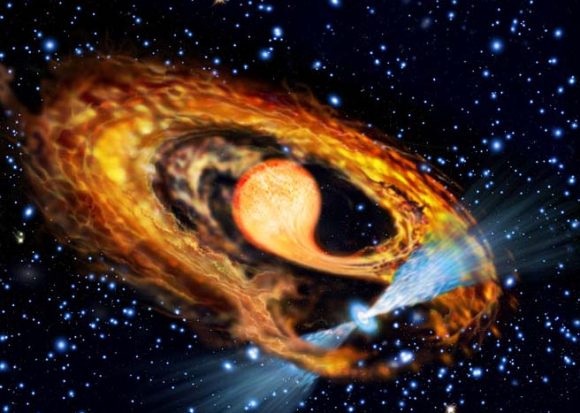
For the sake of their study, which appeared recently in The Astrophysical Journal – titled “An Eccentric Binary Millisecond Pulsar with a Helium White Dwarf Companion in the Galactic Field” – the team relied on newly obtained optical photometry of the system provided by the Sloan Digital Sky Survey (SDSS), and spectroscopy from the Very Large Telescope from the Paranal Observatory in Chile.
In addition, they consulted recent studies that looked at other binary star systems that show this same kind of eccentric relationship. “We now know [of] 5 systems which deviate from this picture in that they have eccentricities of ~0.1 i.e. several orders of magnitude larger that what is expected in the standard scenario,” said Antoniadis. “Interestingly, they all appear to have similar eccentricities and orbital periods.”
From this, they were able to infer the temperature (8600 ± 190 K) and velocity ( km/s) of the white dwarf companion in the binary star system. Combined with constraints placed on the two body’s masses – 0.28 Solar Masses for the white dwarf and 1.4 for the pulsar – as well as their radii and surface gravity, they then tested three possible explanations for how this system came to be.
These included the possibility that neutrons stars (such as the millsecond pulsar being observed here) form through an accretion-induced collapse of a massive white dwarf. Similarly, they considered whether neutron stars undergo a transformation as they accrete material, which results in them becoming quark stars. During this process, the release of gravitational energy would be responsible for inducing the observed eccentricity.
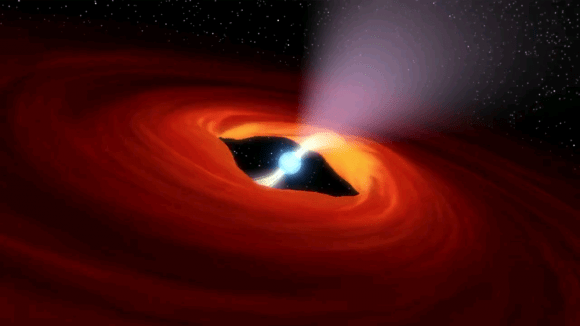
Second, they considered the possibility – consistent with current models of stellar evolution – that LMWDs within a certain mass range have strong stellar winds when they are very young (due to unstable hydrogen fusion). The team therefore looked at whether or not these strong stellar winds could have been what disrupted the orbit of the pulsar earlier in the system’s history.
Last, they considered the possibility that some of the material released from the white dwarf in the past (due to this same stellar wind) could have formed a short-lived circumbinary disk. This disk would then act like a third body, disturbing the system and increasing the eccentricity of the white dwarf’s orbit. In the end, they deemed that the first two scenarios were unlikely, since the mass inferred for the pulsar progenitor was not consistent with either model.
However, the third scenario, in which interaction with a circumbinary disk was responsible for the eccentricity, was consistent with their inferred parameters. What’s more, the third scenario predicts how (within a certain mass range) that there should be no circular binaries with similar orbital periods – which is consistent with all known examples of such systems. As Dr. Antoniadis explained:
“These observations show that the companion star in this system is indeed a low-mass white dwarf. In addition, the mass of the pulsar seems to be too low for #2 and a bit too high for #1. We also study the orbit of the binary in the Milky way, and it looks very similar to what we find for low-mass X-ray binaries. These pieces of evidence together favor the disk hypothesis.”
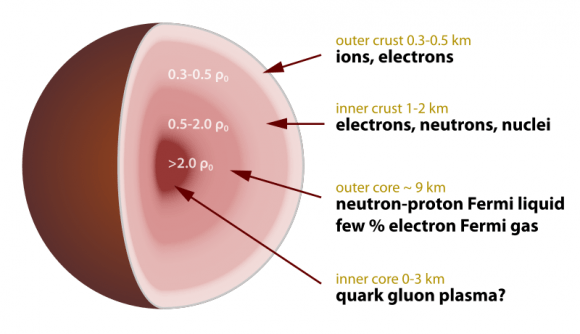
Of course, Dr. Antoniadis and his colleagues admit that more information is needed before their hypothesis can be deemed correct. However, should their results be borne out by future research, then they anticipate that it will be a valuable tool for future astronomers and astrophysicists looking to study the interaction between binary star systems and circumbinary disks.
In addition, the discovery of this high eccentricity binary system will make it easier to measure the masses of Low-Mass White Dwarfs with extreme precision in the coming years. This in turn should help astronomers to better understand the properties of these stars and what leads to their formation.
As history has taught us, understanding the Universe requires a serious commitment to the process of continuous discovery. And the more we discover, the stranger it seems to become, forcing us to reconsider what we think we know about it.
Further Reading: The Astrophysical Journal
How Long Does it Take Mars to Orbit the Sun?
Given it’s similarities to Earth, Mars is often referred to as “Earth’s Twin”. Like Earth, Mars is a terrestrial planet, which means it is composed largely of silicate rock and minerals that are differentiated into a core, mantle and crust. It is also located within the Sun’s “Goldilocks Zone” (aka. habitable zone), has polar ice caps, and once had flowing water on its surface. But beyond these, Mars and Earth are very different worlds.
In addition to their stark contrasts in temperature, surface conditions, and exposure to harmful radiation, Mars also takes a significantly longer time to complete a single orbit of the Sun. In fact, a year on Mars is almost twice as long as a year here on Earth – lasting 686.971 days, which works out to about 1.88 Earth years. And in the course of that orbit, the planet undergoes some rather interesting changes.
Continue reading “How Long Does it Take Mars to Orbit the Sun?”

